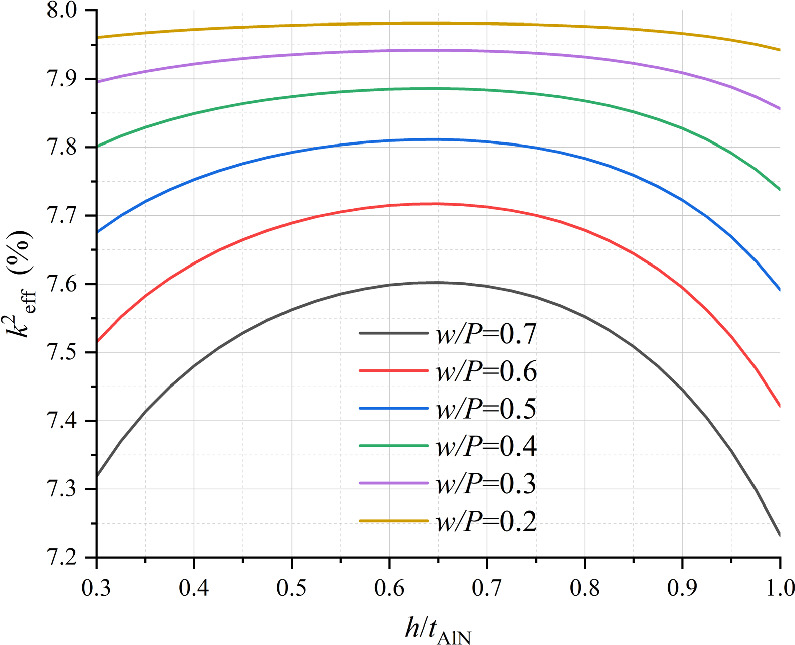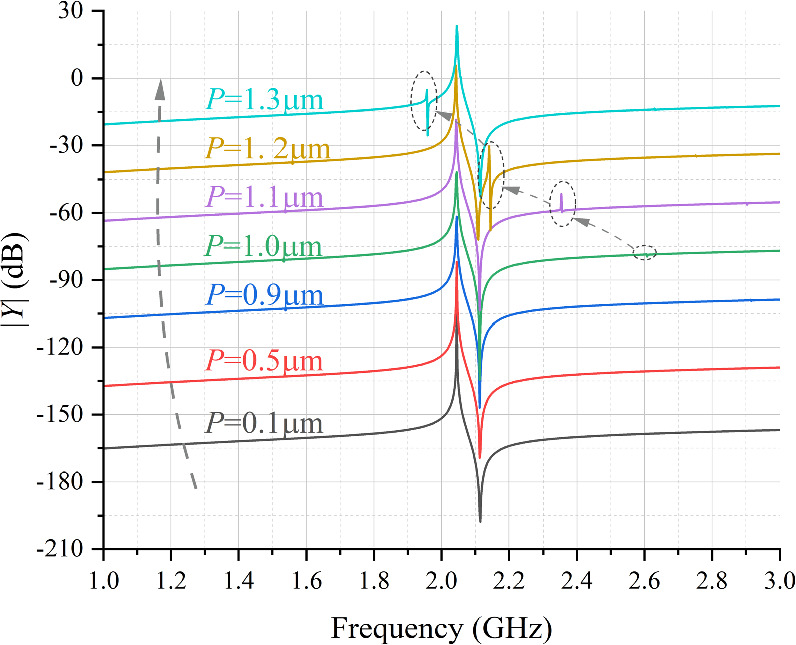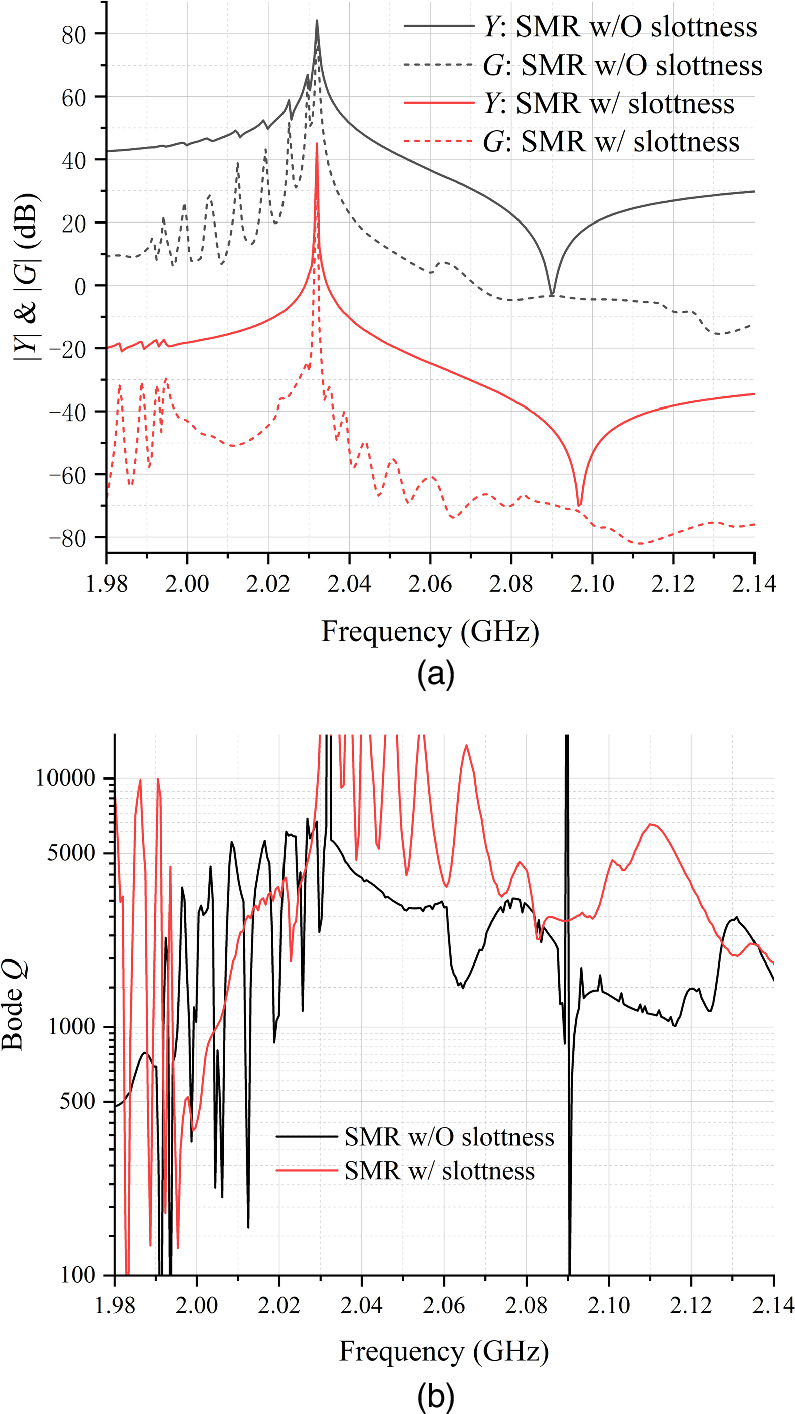Abstract
This paper discusses the applicability of a two-dimensional (2D) periodic pillar array as the first layer of an acoustic mirror for AlN-based solidly mounted resonators of bulk acoustic waves. It is based on the idea that the periodic pillar array behaves like a uniform layer when the period is much smaller than the wavelength and its behavior is given by the ensemble average of pillar materials. The simulation shows that the effective electromechanical coupling factor can be enhanced close to that of AlN-based film bulk acoustic resonators when the slot ratio is large. It is also shown that the use of a 2D pillar array can enhance the reflectivity of the Bragg reflector. It should be noted that the periodic 2D pillar array can also control the anisotropy of wave propagation along the surface. Owing to this, transverse mode resonances can be suppressed well by adjusting the wave dispersion curve properly.
Export citation and abstract BibTeX RIS
1. Introduction
Now, RF bulk acoustic wave (BAW) resonators employing AlN thin films 1–6) are widely used and indispensable in the RF frontend of mobile communication terminals. 7–9)
RF BAW resonators employ acoustic resonance of piezoelectric thin membranes, and they should be isolated acoustically from surroundings necessary for their physical support. This isolation is realized by two methods. One employs physical support of free-standing membranes at their side edges, and this type is called the film bulk acoustic resonator (FBAR). 10,11) Another one employs the Bragg reflector directly attached to the membrane. This type is called a solidly mounted resonator (SMR). 12)
SMR-type BAW resonators possess several advantages such as good power durability and structural robustness compared with FBAR. 8) However, they also have some demerits. One is the reduction of the effective electromechanical coupling factor keff 2 due to penetration of acoustic waves into the Bragg reflector. 10,11) Second is the necessity of a certain number of layers for the acoustic mirror to achieve enough acoustic reflectivity.
In Ref. 13, the authors indicated that keff 2 of SMR can be enhanced close to that of FBAR when the two-dimensional (2D) pillar array made of SiO2 is used as the top SiO2 layer of the Bragg reflector. It should be noted that when the pillars are aligned periodically with a periodicity much smaller than the lateral acoustic wavelength, the structure looks uniform, and its properties are simply given by the ensemble average of those of employed pillar material and air. 14) Furthermore, owing to the periodicity, random scattering does not occur, and thus this configuration is ideally lossless. It was also shown that the use of a 2D periodic pillar array also enhances the reflectivity of the Bragg reflector.
By the way, the periodic arrangement of the 2D pillar array will also create anisotropy of wave propagation along the membrane, and the anisotropy may offer a significant impact on transverse mode resonances, whose complete suppression is mandatory in current high-performance BAW devices. 15–18) Anisotropy control is one of the hottest research topics in surface acoustic wave (SAW) devices for suppression of transverse mode resonances. 19–21) Its basic idea is to make lower-order transverse resonances to the main resonance, and the remaining weak higher-order ones are suppressed well by the piston design, 22–24) which was originally proposed for BAW devices. 15) Anisotropy control is also believed to be crucial to suppress lateral leakage and achieve high Q. 25,26)
This is an extended version of Ref. 13, and discusses the applicability of periodic 2D pillar arrays to the AlN-based SMR-type BAW resonators from various aspects. In addition to enhancement of both keff 2 and reflectivity of the Bragg reflector, anisotropy control is also discussed for suppression of transverse mode resonances and lateral leakage.
2. Basic concept
2.1. Characteristic of multi-layered structure
The properties of periodic structures called photonic or phononic crystals are studied extensively. However, most of the previous works employ the Bragg reflection in the structures for synthesis of desired properties. In this work, the main concern is the use of an ensemble average of employed material properties instead.
First, consider a one-dimensional (1D) muti-layered structure shown in Fig. 1. When the thickness of each layer is assumed to be much smaller than the acoustic wavelength, the structure can be regarded as homogenous material, and the compliance toward the thickness direction is given by the ensemble average of compliance of the layer while the stiffness of the in-plane directions is given by ensemble average of stiffness of layers. This means when very soft and very hard materials are combined for example, this structure looks very soft toward the thickness direction and very hard toward the lateral directions. Thus, large anisotropy can be synthesized. It should be noted that when the layer composition is periodic and its periodicity is much smaller than the acoustic wavelength, scattering does not occur except for reflection at the top and bottom surfaces due to intrinsic impedance mismatch.
Fig. 1. Multi-layered structure.
Download figure:
Standard image High-resolution image2.2. Resonator design
According to this principle described in Sect. 2.1, the periodic 2D pillar array is arranged as Fig. 2(a) and embedded in the Bragg reflector composed of SiO2 and W in the AlN-based SMR as shown in Figs. 2(b) and 2(c). Pillar material is SiO2 and gaps among pillars are vacant, i.e., vacuum. The portion framed by dotted red lines is the unit cell of a period P and the width w of pillars are equal in the x- and y-directions, thus the structure possesses four-fold symmetry in the x–y plane.
Fig. 2. (a) Structure of periodic pillar array; (b) periodic 3D FEM model; and (c) cross-sectional view. 13)
Download figure:
Standard image High-resolution imageThe 3D periodic finite element method (FEM) is applied for the structure shown in Figs. 2(b) and 2(c). The periodic boundary conditions are given to all side boundaries, and a perfect matching layer (PML) is given to the Si bottom surface. Designed structural parameters defined in Fig. 2(c) are listed in Table I. It should be noted that each layer thickness of the Bragg reflector is set to obtain relatively high reflectivity for both longitudinal and shear waves. 27)
Table I. Designed structural parameters.
| Parameters | Value |
|---|---|
| Piezoelectric layer thickness (tAlN) | 1 μm |
| Electrode thickness (tRu) | 0.3 μm |
| Low impedance layer thickness (tL) | 0.53 μm |
| High impedance layer thickness (tH) | 0.94 μm |
| Periodicity of pillars (P) | P |
| Pillar thickness (h) | h |
| Width of pillar (w) | w |
| Duty ratio of SiO2 (w/P) | w/P |
3. keff 2 and reflectance enhancement
First, P is set very tiny (10 nm) making the pillar array behave uniformly.
Figure 3 shows the variation of the effective coupling coefficient keff 2 with h/tAlN and w/P, where keff 2 is defined as:

where fr and fa are the resonance and anti-resonance frequencies, respectively. It is seen that keff 2 changes parabolically with h/tAlN and takes a maximum when h/tAlN ∼0.65. On the one hand, keff 2 increases monotonically with a decrease of w/P and becomes insensitive to h/tAlN. Note that keff 2 in this configuration is 8.01% for the free-standing FBAR and that of SMR-BAW with uniform SiO2 is 7.01%.
Fig. 3. Variation of keff 2 with h and w/P. 13)
Download figure:
Standard image High-resolution imageFigure 4 shows the admittance Y characteristics of SMR-BAW resonators without and with slotted SiO2 with w/P = 0.4 and h/tAlN = 0.65. The addition of the slotted pillars enhances keff 2 from 7.08% to 7.88% without generating spurious resonances.
Fig. 4. Y of SMR-BAW resonators. Blue: without slotted pillars and orange: with slotted pillars.
Download figure:
Standard image High-resolution imageNext, variation of Y with P is investigated for the case where w/P and h are fixed at 0.4 and 0.65 μm, respectively and Figure 5 shows the result. With an increase in P, a spurious resonance appears close to the main resonance and overlaps with it. This spurious response is caused by coupling between the thickness resonance and that of the pillars. This spurious resonance seems insignificant when P is smaller than 1 μm.
Fig. 5. Variation of Y with P.
Download figure:
Standard image High-resolution imageFigure 6 shows the variation of the Bode Q 28) with the number N of Bragg reflector layers. Two types of calculations are shown: (a) with slotted SiO2, and (b) without slotted SiO2. In these calculations, P, h, and w/P are equal to 0.7 μm, 0.65 μm, and 0.4, respectively. The Q enhancement is obvious. Namely, a relatively high Q close to 5000 can be achievable even at N = 2 when the slotted SiO2 is applied while N = 4 is necessary to get reasonable Q when the slotted SiO2 is not applied.
Fig. 6. Variation of Bode Q with the number N of Bragg reflector layers. 13)
Download figure:
Standard image High-resolution image4. Dispersion control and transverse modes suppression
The wavenumber βx of laterally propagating SAW is calculated as a function of frequency f for the structure shown in Fig. 2. In this case, a phase shift of -βx P is given between left and right boundaries in the FEM model of Fig. 2(c), and the eigenfrequency f of the unit cell is calculated by changing βx .
Figure 7 shows the variation of this βx –f relation with w/P. Two kinds of branches are given in this figure. Solid lines are those given by the conventional SAW mode existing even when the slots are not given while broken lines are those given by the "pillar" mode which is generated by coupling of the SAW mode with the pillar resonance (See the resonance pattern given in the lower right corner of the figure).
Fig. 7. Variation of βx –f relation of the SAW mode (solid line) and pillar mode (broken line) with w/P, and the field pattern of the pillar resonance is given in the lower right corner.
Download figure:
Standard image High-resolution imageIt is seen that when two branches are far, the SAW mode branch exhibits the so-called type-Ⅱ dispersion where f decreases with βx . When two branches are in proximity, the SAW mode branch is bent and changed to the type-I dispersion, where f increases with βx when 0.48 < w/P < 0.49, and the dispersion curve becomes maximally flat when w/P = 0.47. This result reveals that the change in the dispersion relation is caused by the coupling of the SAW mode with the pillar mode.
Next, the influence of the dispersion control is investigated using a 3D FEM model shown in Fig. 8 where the periodic boundary condition is given to the y-direction. Periodic pillars are extended to the outside of the active region with a width of 60 μm to avoid discontinuity at side boundaries of the active region. In addition, Al rims are given there for Q enhancement, 29,30) and their thickness tr and width wr are set at 0.5 μm and 0.4 μm, respectively. PMLs are applied to two sides and bottom of the whole structure.
Fig. 8. 3D FEM model where the periodic condition is applied to the y-direction.
Download figure:
Standard image High-resolution imageFigure 9(a) shows the calculated Y and G of the structure. For comparison, those cases without the slots are also shown in the figure. When the slots are not given, owing to the type-Ⅱ dispersion, a series of transverse resonances appear below the main resonance. 16) In contrast, owing to the flattened dispersion, these spurious resonances are well suppressed when the slots are given. In addition, keff 2 is increased significantly. Figure 9(b) shows calculated Bode Q. 28) It is seen that the Q value is also enhanced significantly by applying the periodic slots.
Fig. 9. Calculated Y and G (a) with Bode Q (b) of the resonator structure with slotted SiO2 (orange) and without slotted SiO2 (black).
Download figure:
Standard image High-resolution image5. Conclusions
This paper discussed the applicability of the 2D periodic pillar array as the first layer of the acoustic mirror for AlN-based SMR-BAW resonators.
It was shown that keff 2 can be enhanced close to that of free-standing FBAR when w/P is set small. It was also shown that the use of a 2D pillar array can enhance the reflectivity of the Bragg reflector.
It was demonstrated that SAW propagation along the surface can be controlled owing to anisotropy created by the periodic 2D pillar arrays, and transverse mode resonances can be suppressed well under the proper setting of the periodic 2D pillar arrays.
Acknowledgments
This work was supported by the Research Project under Grant A1098531023601318 and in part by the National Natural Science Foundation of China and the China Academy of Engineering Physics under Grant U1430102.










